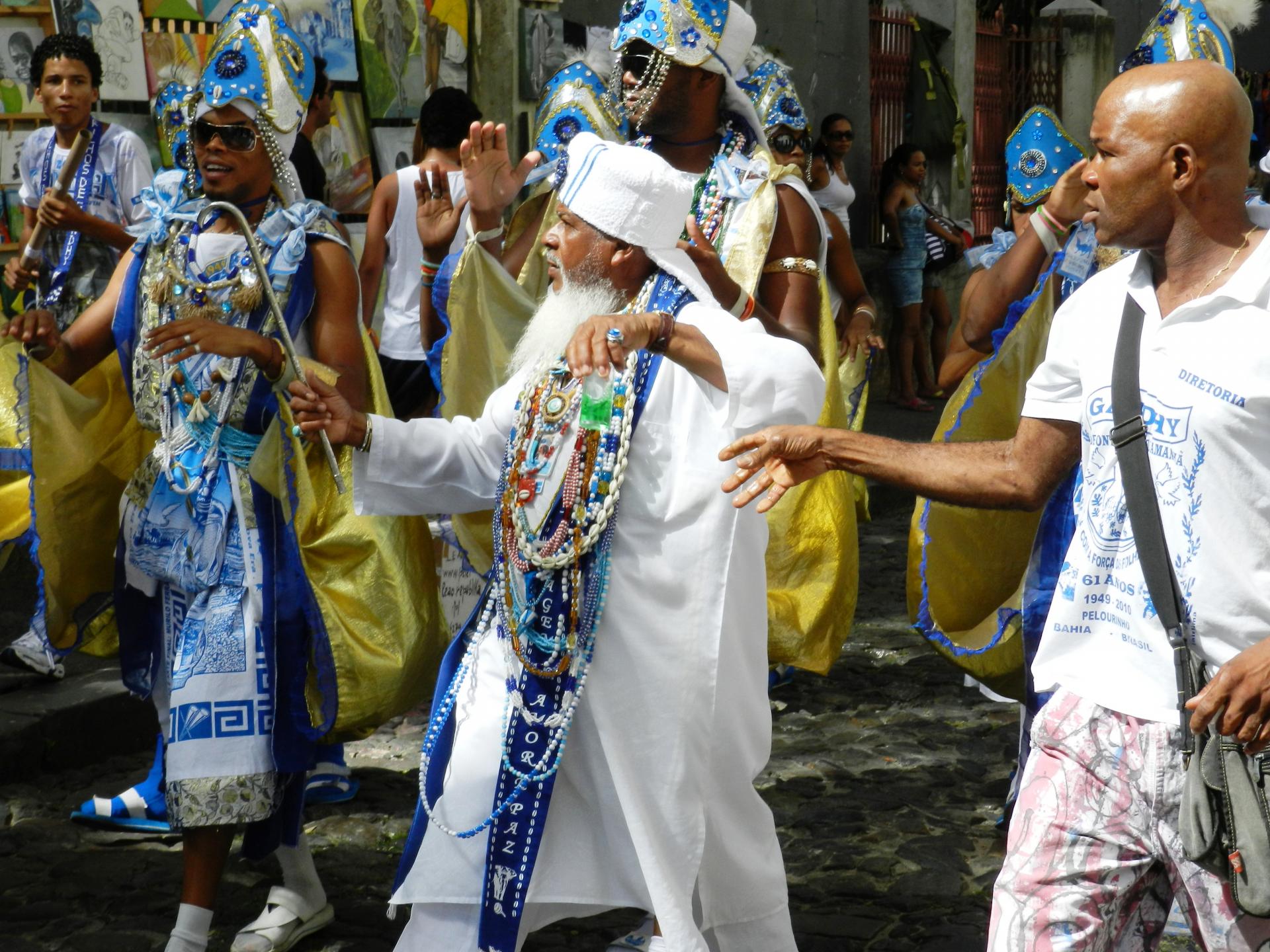Rhythms of Brazil: Afoxé and Ijexá

Carnival in Brazil is one of the biggest folk festivals in the world and a very special experience during a trip to Brazil. Especially in the carnival strongholds Rio de Janeiro, Olinda, or Salvador there is a state of emergency during the days. It is impossible to sit still and just watch because at the carnival in Salvador da Bahia the drums and the sound of the afoxé provide a rousing contrast to the electrifying sounds of the carnival floats. Among the best-known representatives of afoxé are the Filhos de Ghandy. But afoxé groups can also be found in Ceará, Pernambuco, Rio de Janeiro, or São Paulo.
Ijexá
The genre ijexá has its origin in the rhythms dedicated to the orixás, the gods in the rituals of Candomblé. In Candomblé, ijexá belongs to the alaketu rhythms, those played with drumsticks. The name refers to Ilesha, a city in Nigeria.
At the end of the 19th century, followers of the Afro-Brazilian religion began street parades with songs in the rhythm of ijexá, accompanied by the instruments atabaque, agogô, afoxé, and xequerê. These groups were called afoxé. In time, the rhythm was adopted by commercial popular music. In 1930, Bahian singer and composer Josué de Barros released "Babaô Miloquê", which is considered the first recording of ijexá. Beginning in the 1970s, the genre spread into Brazil's popular music scene as a sung style that is slower than usually heard in church services and street parades. Other examples of ijexá songs include "Afoché" by Dorival Caymmi, "Filhos de Gandhi" by Gilberto Gil, "Beleza Pura" by Caetano Veloso, "Ijexá" by Edil Pacheco, and "É D'Oxum" by Vevé Calazans and Gerônimo.
Afoxé
The word afoxé is of Yoruba origin and could be translated as "the language that makes it happen". Afoxé is a symbol of African culture, closely linked to religion and music. Afoxé is most characteristic of Bahia but is also present in other Brazilian states, including Pernambuco, Maranhão, Rio de Janeiro, and São Paulo.
The Portuguese language and some African languages, such as Nagô, are mixed in the songs of afoxé. Very important are the rhythms, which are mainly characterized by percussion instruments such as atabaques and agogôs. Three instruments are essential for the rhythm:
- Afoxé, also called agbê: It is a gourd covered with a net of beads or seeds. By shaking the net, which rubs against the gourd, the gourd makes the sound.
- Atabaques: Three different barrel drums of three different sizes are used.
- Agogô: Consists of two metal bells with different sounds and sets the rhythm for the other instruments.
The afoxé is far from being just a synonym for the carnival block. It is a manifestation deeply linked to the religious manifestations of Candomblé. The melodies intoned in the processions of the afoxés are practically the same songs used in Afro-Brazilian ceremonies. For this reason, afoxé is often referred to as "street Candomblé." Today, however, afoxé is seen mostly at carnival time, in regions of Brazil that celebrate carnival more intensely.
Filhos de Ghandhy - Well-known representatives of Afoxé
In 1949, dockworkers were still considered privileged, since economic conditions were favorable at that time and they were supervised by the dockworkers' union itself. However, during the year, the Brazilian federal government intervened in the activity of unions, including the dockworkers' union, with the policy of wage cuts caused by the postwar crisis. This led to a drop in the income of union members.
As a result, Durval Marques da Silva, also known as Vavá Madeira, proposed to create a cordão, a carnival block. It was on February 18, 1949, that Vavá and his colleagues founded the bloco Filhos de Gandhy. In 1951, the bloco began to include workers from other areas. Today, it represents the largest and most beautiful afoxé of the carnival in Salvador da Bahia, attracting people from all over Brazil and abroad. The bloco is made up exclusively of men and among its most famous representatives are Gilberto Gil, Gerônimo, Xanddy Harmonia, Carlinhos Brown, and Tonho Matéria. The Filhos de Gandhy began singing carnival songs in the early years until they devoted themselves mainly to the ijexá and also composed their songs. The afoxé is one of the many cultural developments of the traditional Afro-Brazilian religions in Brazil.
The name of the bloco was proposed by Vavá Madeira, inspired by the life of the Indian pacifist leader Mohandas Karamchand Gandhi, but the letter "i" was replaced by "y" to avoid possible reprisals for using the name of a well-known personality. The bloco was christened "Filhos de Gandhy", which means "Sons of Gandhy" in English.
The costume symbolizes the Indian garments and consists of a white sheet with a painting on the front. To complete the costume follow a turban, a pair of sandals, socks, and a sash. The necklaces in blue and white are worn in honor of the orixás Oxalá and Ogum.
In addition to carnival, the Filhos de Gandhy also participate in religious festivals. These include Lavagem da Igreja do Bonfim, Dia de Iemanjá, Xangô, Oxum, Santa Bárbara and Iansã, São Cosme and Damião. The cultural, recreational, and carnival association Filhos de Gandhy is also involved in social activities, such as distributing meals to the needy.
Maybe you will have the chance to join the carnival hustle and bustle of Salvador da Bahia during your next Brazil vacation. Not only will you get to see the sights of Salvador, but you can also relax on beautiful beaches, sample Bahia's delicious specialties, and participate in Brazil's largest popular festival.
Sources: www.bibliotecaderitmos.com.br, www.salvadordabahia.com, www.sonsdobrasil.art.br, www.wikipedia.org

